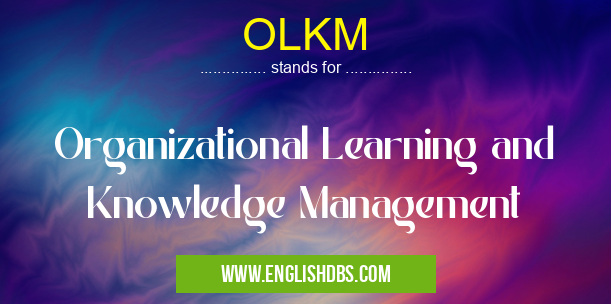What does OLKM mean in EDUCATIONAL
Organizational Learning and Knowledge Management (OLKM) is an integrated approach to leveraging an organization’s internal resources to identify, capture, share, and apply existing knowledge to create a learning environment that drives the organizations innovation capabilities. OLKM focuses on increasing the proficiency of employees by enabling them to access organizational resources both within their current position and across the organization.

OLKM meaning in Educational in Community
OLKM mostly used in an acronym Educational in Category Community that means Organizational Learning and Knowledge Management
Shorthand: OLKM,
Full Form: Organizational Learning and Knowledge Management
For more information of "Organizational Learning and Knowledge Management", see the section below.
» Community » Educational
Essential Questions and Answers on Organizational Learning and Knowledge Management in "COMMUNITY»EDUCATIONAL"
What is Organizational Learning and Knowledge Management?
How does Organizational Learning and Knowledge Management work?
Organizational Learning and Knowledge Management works by allowing organizational stakeholders to draw upon their collective insights, skills, experiences as well as any structured or unstructured data contained within an organization’s IT systems. This makes it possible for decision-makers to make better informed decisions more quickly. OLKM also increases the value of a company’s intellectual property by making the information it contains discoverable, accessible and usable throughout its internal operations.
What benefits does Organizational Learning and Knowledge Management offer?
Implementing OLKM can bring multiple benefits including increased innovation cycles through faster development of new products and services; improved customer service positioning by optimizing customer experience across all channels; streamlined employee training by equipping personnel with up-to-date knowledge through access to relevant resources when needed; greater efficiency in problem solving activities since employees can leverage each other’s expertise; as well as reduced costs related to training materials for staff onboarding.
How is Organizational Learning and Knowledge Management implemented?
Implementation of OLKM requires careful planning prior to launch. The process should begin with evaluating current processes within your organization. Once you have identified potential areas where information needs could be addressed more effectively, you can focus on designing solutions that support organizational objectives such as creating a collaborative workplace culture or improving customer service delivery. The next step is selecting tools that will enable users to access available knowledge easily and securely while also ensuring compliance with relevant regulations. Finally, it is important to ensure adequate training for users on how they should use these resources efficiently.
Who should be involved in implementing Organization Learning and Knowledge Management?
Implementation of OLKM should involve a multidisciplinary team composed of members from various departments who possess different perspectives on business processes so that all stakeholders can participate in defining required changes needed for successful adoption of OLKM within their organization. It is also important for senior management to be heavily involved in order for them set the example of using this system properly throughout all levels of the enterprise once it has been deployed.
What are some technologies used in Organization Learning and Knowledge Management implementation?
Technologies used in OLKM implementation include content management systems such as wikis which allow users to store documents collaboratively; knowledge bases which contain structured information about frequently asked questions which are organized into categorized topics; collaboration platforms like intranets for secure communication between employees working remotely; document sharing tools such as cloud storage services making documents available anytime/anywhere; discussion forums where people can engage in conversations about key topics; search engines allowing users to find specific types of information quickly; social media platforms supporting interactive learning initiatives among peers inside or outside an organization.
